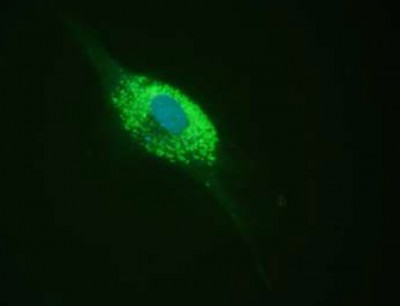The Histone Demethylase FBXL10 (also known as NDY1, KDM2B, or JHDM1B) has been reported to demethylate histone H3K4me3. By removing active Methyl Epigenetic marks on the chromatin, this “Epigenetic Eraser” thus inactivates gene transcription.
FBXL10 harbours various functional domains (1):
- a Jumonji C (JmjC) domain (common to Jumonji family Transcription Factors)
- a zinc-finger (CXXC) domain, a Plant Homeo Domain (PHD) finger
- Proline-rich and Leucine-rich repeat domains
- a F-box domain (a motif of approx. 50 amino acids which plays a role in protein-protein interaction).
In experiments in overexpressed and KD cellular models, it has been shown that FBXL10 exhibits regulatory effects in cell morphology, chemokine expression, and cellular metabolic control (2). Furthermore, scientists have found a significant overexpression of FBXL10 in human bladder carcinoma cells as well as human leukemia cells (3, 4). It has been proposed that FBXL10 is a crucial factor for leukemogenesis and the self-renewal of leukemia stem cells (3).

Hence this factor might become an interesting pharmaceutical target for inhibitor screening in the near future.
In the past, the only assays available to detect the physical presence of FBXL10 were ELISA kits. Even if specific, these ELISAs did not allow FBXL10 inhibitor screenings, which are usually based on assays measuring the enzymatic activity of the target of interest.
To overcome this hurdle, BPS Biosciences has released the first FBXL10 activity assay.
This unique enzymatic assay makes inhibitor screening possible through a 384-well plate AlphaLISA technology.
Interestingly, and in response to assay developers’ and screeners’ needs, the kit is designed as a homogenous assay, and the active FBXL10 enzyme is available separately as well!
If you have in mind building inhibitor screenings on FBXL10 or if you’re interested in more information about the kit, just leave your comments or questions below!
By the way, which Epigenetics Eraser would you like to screen?
External references
(1) Pfau et al., Proc Natl Acad Sci U.S.A. 105 (6), 2008, p. 1907-12.
(2) Janzer et al., J Bio. Chem. 287 (37), 2012, p. 30984-92.
(3) He et al., Blood 117 (14), 2011, p. 3869–80.
(4) Kottakis et al., Mol Cell. 43 (2), 2011, p. 285-98.



